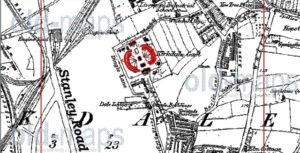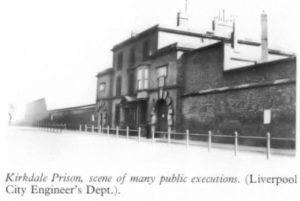MARY CORRIGAN MURDER 1873 by brian starkey, retired
One of the most horrific murders in Liverpool during the 19th century was that of Mary Corrigan on Saturday 1st. November 1873.
Mary with her husband occupied the house at 36, Chisenhale Street, Liverpool, which was kept as a common lodging house. Also in the house on that fateful day was her son Thomas, aged 23 years and a woman named Martha Knight who Thomas had been cohabiting with for some months; another lodger called James Canavan and the Harris family consisting of husband and wife, Richard and Johanna and three children. They occupied a room on the first floor and Thomas Corrigan and his cohabite occupied the room above that. Mary and her husband occupied the kitchen and an adjacent small room called the ‘Parlour’.
At about 6-00pm on Saturday 1/11/1873 Thomas, who was worse for drink entered the house and went to his room where he slept for some time. Also in the room was Knight. In the kitchen was Mary Corrigan, her husband, the lodger Canavan and Mr and Mrs Harris.
It would appear that Mary did not like the woman Knight and her association with her son. Mary had been drinking during the day and started crying and complaining about Knight. Thomas had slept for half an hour and was awoken by the complaints of his mother. He became outraged and immediately ran downstairs to confront her. He asked his mother where his supper was and she put him off by saying it was in the oven. On looking in the oven he found it not to be there. He then commenced a brutal attack on his mother that resulted in her death. He punched her in the face and then grabbed her by the hair and smashed her head on the floor a number of times. He shouted “I’ll clear this house” and commenced to attack his own father who fled out of the house. He then seized Mr. Harris and on realising who it was let go. He then attacked Canavan and knocked him to the ground. Canavan got to his feet and ran out of the house. Thomas then bolted and locked the front door and having done so recommenced his attack on his mother. He grabbed hold of the table with both hands and commenced to jump up and down on her until she was unconscious. Realising this he shouted to Knight, who was upstairs, to bring him some water which she did. He then used the water to bring his mother to her senses. He then got Knight and Mrs. Harris to strip his mother and put her to bed in the ‘Parlour’. He then commenced to attack Knight and whilst doing this Mary in great fear got out of bed and crept upstairs into the bedroom occupied by the Harris’s. Mr Harris had gone upstairs to his children believing the row to be over.
Thomas then realised that his mother was missing from the ‘Parlour’ and went looking for her. He found her crouching at the foot of the bed in Harris’s room. He then commenced a further attack on her. He removed his belt and struck her several times on the head and body with the buckle. He then either threw her or pushed her down the stairs. He followed her down and continued to beat her with the buckle end of his belt. He then continued to kick and stamp on her until she was unconscious. He then got a kitchen knife and placed it across her throat but he did not inflict any injury. Mary again was placed in bed and died a short time later. On being told she was dead Thomas demanded his boots and said he would be off and, when enquiries were made about his mothers death for others to say that she had been drinking and had fallen. He then left the house.
About half an hour later Thomas was in Chisenhale Street when he was arrested by Police Officer, Thomas McDonald. By this time he was sober and calmly told the officer that he was going for the doctor because his mother had died suddenly.
Corrigan was charged with the murder of his mother and appeared before Mr. Justice Quain at Liverpool Assizes and in answer to the Judge said that no Counsel had been appointed to represent him. The Judge then appointed a Mr. Thurlow to undertake the task. The learned Counsel then put it to the jury that Corrigan, at the time he committed the act, was labouring under more than an ordinary degree of drunkenness; he was under some sudden fit of ‘the horrors’. If the jury believed that he was in that unnatural state brought on by drink they should say that there was no intent in his mind which went to show that he intended to murder his mother and the crime was one of manslaughter. After hearing all of the evidence the jury found Corrigan guilty of murder.
On sentencing Corrigan to death Mr. Justice Quain said that it “disclosed a state of brutality so shocking he never heard anything like it before”. Corrigan was then taken down and transferred to Kirkdale Gaol.
The Execution
The date of execution was fixed to take place at 8-00am on Monday 5th January 1874. the usual hour appointed for executions. It was a light grey dawn when those allowed were admitted into the gaol yard to witness the execution. From where they stood they could see the ghastly looking gallows, draped in black as it used to be at public executions, with the hangman’s hook in the centre of the crossbeam, the short chain and the hangman’s rope twirled around it.
The only persons present at the execution were the Under Sherriff, Governor of the gaol, prison warders and about a dozen representatives of the press. The prison bell started to toll a few minutes before 8-00am and those present took their places near to the gallows.
During the early hours of the morning Corrigan had been moved from his cell to a store room, the entrance to which was near to the steps leading directly to the gallows. Corrigan was perfectly resigned to his fate but hope clung to him that his fate would be spared. This hope was dispelled when he was led from the store room towards the gallows. With him was the Rev. Father Bonte. Corrigan was very prayerful the whole of the time he was engaged with the priest.
It had been expected that Hangman Calcraft would perform the execution, but he could not make it and his assistant, Hangman Anderson – Owen took his place to perform his first execution.
Shortly after the prison clock struck 8 o’clock the procession, headed by Mr Hyslop, the Chief Warder of the gaol, ascended the steps of the gallows. Corrigan whose arms were pinioned, walked unsupported. To his right was the Rev. Father Bonte. Following was the Under Sherriff, the Governor of the gaol and 4 or 5 Warders. Corrigan walked directly under the beam and placed his hands in the attitude of prayer. The Executioner set about his work quickly, strapped the convicts legs, placed the noose around his neck, put the white cap over his face, drew the fatal bolt and Corrigan fell. There was a slight struggle after the fall but it is believed he died quickly. In a few seconds the body was still, but after the Executioner and officials had left, a slight quivering of the frame told that he had not died instantly but gradually ebbed away. After the execution the black flag was raised to indicate to those outside that the execution had taken place.
After the body had remained hanging for about an hour, the Executioner returned with the Chief Warder and two prisoners wearing their prison uniforms. Corrigan was lifted off the hook and taken to a nearby room. The body was then placed in a black painted coffin and quickly buried in the ‘Murderers Churchyard’ within the gaol.
Source: Old Mersey Times
Brian Starkey
August 2012



